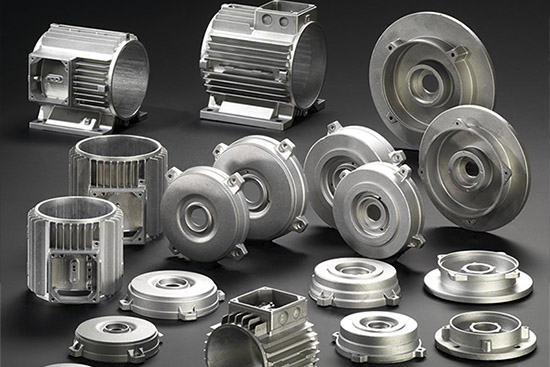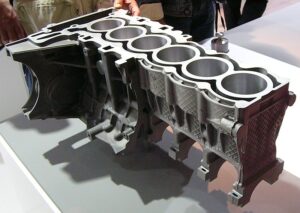Curious about how car parts, toys, and complex gadgets are made? In this article, we’ll explore die casting – a precise and efficient manufacturing technique. From intricate details to grand designs, die casting covers it all. Whether you’re a curious learner or just love understanding how things work, this is your chance to grasp the magic behind die casting. Let’s dive in and uncover the process!
Understanding the Basics of Die Casting
Die casting, a versatile manufacturing process involves injecting molten metal into molds under intense pressure. This intricate procedure is highly favored across various industries that require precision-crafted components.
How Die Casting Works
At the core of die casting is the meticulous creation of a steel mold, divided into two halves: the “cover die” and the “ejector die.” Molten metal is injected into the mold under high pressure, filling every contour precisely. The process begins with designing and crafting precision molds, usually from durable steel that withstands intense pressure and temperature. The molten metal, often an aluminum, zinc, or magnesium alloy, is forced into the mold at high pressure, rapidly solidifying into its precise shape.
Types of Die Casting
Hot and cold chamber die casting shapes intricate metal parts for various sectors with method choice depending on metal properties, application needs, and production efficiency.
-
Hot Chamber Die Casting
Hot chamber die casting, or gooseneck casting, involves immersing the injection system in molten metal. A hydraulic piston, powered by a motor-driven plunger, draws the molten metal into the die cavity. Suitable for low melting point alloys like zinc, tin, and lead-based ones, provided they won’t damage the injection system.
-
Cold Chamber Die Casting
Cold chamber die casting involves pouring molten metal into the injection system and forcefully injecting it into the die cavity using a hydraulic piston. This method suits high-melting alloys like aluminum, magnesium, and copper-based ones without compromising the injection system.
Advantages of Die Casting
Die casting offers several advantages due to its unique manufacturing process. Here are the key benefits:
- Precision and Consistency: Die casting delivers highly precise and consistent results. The molds, or dies, used in the process ensure tight tolerances and accurate shapes, resulting in uniform parts that meet exact specifications.
- Complex Geometry: The process is ideal for creating complex intricate shapes with fine details. The molds can be intricately designed, allowing for the production of parts with intricate features that might be difficult or expensive to achieve through other methods.
- High Production Rates: Die casting is a high-speed production method. It allows rapid production of large quantities of parts in a relatively short amount of time, making it cost-effective for mass production.
- Excellent Surface Finish: Die-cast parts possess smooth, uniform surfaces, often needing minimal post-work. This efficiency saves time and costs.
- Material Variety: Die casting welcomes a spectrum of metals, including aluminum, zinc, and magnesium. This variety empowers manufacturers to tailor metal choices for specific uses.
- Strength and Durability: Die-cast parts exhibit high strength and durability due to the rapid solidification process. The uniform grain structure enhances mechanical properties, making the parts capable of withstanding high loads and stresses.
- Reduced Waste: The die casting process generates minimal waste as scrap material can be easily recycled and reused, reducing material costs and environmental impact.
- Tight Tolerances: The precise nature of die casting ensures tight dimensional tolerances and consistent part-to-part reproducibility. It is crucial for industries that demand precise specifications.
- Cost Efficiency: While the initial tooling costs can be high, die casting becomes cost-efficient over the long run due to its high-speed production, minimal labor requirements, and low material waste.
- Integration of Inserts: Die casting allows the incorporation of inserts or other components during the casting process, reducing the need for additional assembly steps.
Materials Utilized in Die Casting
Die casting works with diverse materials, each with distinct properties for various uses.
- Aluminum alloys are chosen for their lightweight nature, excellent thermal conductivity, and corrosion resistance. They’re favored in automotive and aerospace applications where weight reduction is vital.
- Zinc alloys are cherished for their stability, precision, and ability to craft intricate shapes. They’re common in consumer electronics, automotive parts, and household appliances.
- Magnesium alloys combine strength and lightness, making them ideal for aerospace, automotive, and medical devices.
Die Casting’s Pervasive Presence in Industries
Die casting is pivotal across industries, creating crucial components for modern technology and infrastructure.
Die casting manufactures engine components, transmission parts, and vehicle structural elements in the automotive industry. The precision and repeatability of die casting ensure critical components meet stringent quality and performance standards.
In electronics, die casting produces components like connectors, housings, and heat sinks. Die casting’s ability to create intricate shapes with tight tolerances makes it ideal for electronic applications.
Aerospace engineering relies on die casting for lightweight yet strong components, crucial for aircraft efficiency and safety. Die-cast components, from engine parts to structural elements, maintain high industry standards in the aerospace sector.
Mold Design: The Crucial Catalyst
Mold design highly impacts die casting’s success. It guides metal flow, cooling, solidification, and part ejection. A good design ensures even metal distribution, preventing defects.
Cooling channel placement is crucial in mold design, ensuring uniform metal solidification and reducing internal stresses and defects. The ejection system’s design is also critical in determining safe part removal from the mold.
Die Casting Process Step-by-Step
Die casting involves coordinated steps, each crucial in crafting high-quality components.
- Firm Clamping: The mold halves securely close and clamp, creating a sealed cavity to shape molten metal into the desired component.
- Molten Metal Injection: Molten metal is injected into the mold cavity under high pressure, rapidly taking the mold’s intricate shape.
- Efficient Cooling: After filling, efficient cooling guarantees the metal solidifies uniformly and quickly, maintaining the desired component’s integrity.
- Ejection Mastery: Once solidified, the mold opens, and the finished component is gently removed using the ejection system.
Ensuring Quality: Scrutiny in Die Casting
Quality assurance requires advanced techniques and meticulous attention.
X-ray imaging detects hidden defects like porosity or voids, while visual inspections identify surface irregularities, blemishes, or cosmetic issues impacting functionality or appearance.
Dimensional measurements ensure components match specifications, and precision tools secure conformity.
Quality Inspections uncover issues like metal pores, size differences from shrinkage, and surface flaws affecting aesthetics.
Sustainability Embedded in Die Casting
The die casting industry reduces its environmental impact through sustainable practices.
- Metal Recycling: Die casting operations generate scrap metal, which can be recycled and reused, reducing the need for new materials and minimizing waste.
- Energy Efficiency: Die casting firms adopt energy-efficient technologies to cut energy use in production. They optimize heating and cooling, use energy-saving equipment, and implement advanced controls to minimize waste.
With these sustainable practices, the die casting industry aims to shrink its environmental impact, ensuring top-notch components for various industries.
Forward March: Future Trends in Die Casting
The die casting industry is making substantial progress, enhancing its capabilities and shaping modern manufacturing.
-
Material Innovations
- Researchers and manufacturers explore new alloy compositions with improved mechanical properties, corrosion resistance, and other desired traits. These innovations will expand the range of applications of die casting.
-
Process Automation
- Die casting operations are adopting automation and robotics to enhance efficiency and consistency. These automated systems handle tasks, including mold loading, metal injection, and part ejection, reducing manual labor and errors.
-
Virtual Simulations
- Advanced computer simulations are essential in die casting, predicting molten metal flow, solidification, and mold interaction. It helps optimize mold designs and production parameters before physical production starts.
Picking the proper die casting manufacturer is crucial, impacting project success. When you’re looking at potential partners, remember to consider various factors.
- Expertise: When choosing a manufacturer for die casting, prioritize those with proven expertise. Experience is essential as it ensures familiarity with the process and the ability to deliver top-quality components.
- Technological Adeptness: Choose a reputable die casting manufacturer that invests in modern technology and equipment, improving quality and efficiency.
- Commitment to Excellence: Select a partner that values quality and is dedicated to meeting your specifications. Look for certifications and quality management systems that prove their commitment to top-tier components.
- Collaborative Approach: Effective communication and collaboration are essential for a partnership. A partner who actively engages provides updates, and addresses concerns adds immense value to the alliance.
Conclusion
So, here’s the bottom line; die casting has transformed modern manufacturing by enabling the creation of complex metal components with precision and speed. Its applications span industries, driving advancements in automotive technology, electronics, aerospace, and more. As the manufacturing landscape evolves, die casting adapts and innovates, cementing its role as a main player in efficient and precise component production.
FAQs: Addressing Common Curiosities
- Is die casting ideal for mass production?
-
- Die casting’s efficiency and rapid production cycles make it a prime candidate for large-scale manufacturing, ensuring unwavering quality across extensive quantities.
- What flaws can appear in die-cast parts?
-
- Frequently encountered imperfections in metal components encompass porosity (small voids or pockets), shrinkage (resulting in size fluctuations), and surface irregularities.
- Are there restrictions to achievable shapes via die casting?
-
- While die casting proves versatile for various shapes, the realm of intricate designs featuring delicate walls or complex inner details presents challenges in mold design and metal flow management.
- Can recycled metal be incorporated into die casting?
-
- Recycling scrap metal in die casting is a sustainable choice that involves repurposing materials and decreasing environmental impact.
- How does die casting compare to 3D printing for metal parts?
- Die casting excels in large-scale production due to efficiency, precision, and speed. On the flip side, 3D printing, with its design flexibility, thrives in prototypes and smaller batches.



